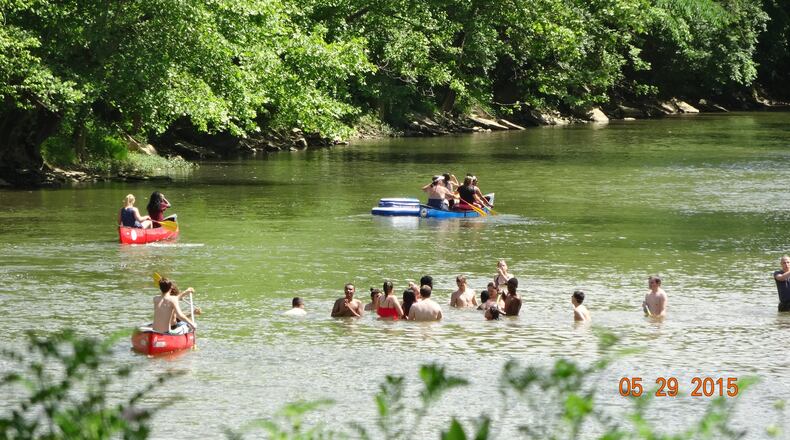“We celebrate that here, in our 5oth year of organization, since 1967 when newspaperman Glenn Thompson founded the organization in the effort to save the Little Miami,” Eric Partee, executive director of the conservancy, said last week, standing along the bank of the Robert K. Finley Jr. Riverfront Nature Preserve, southeast of Waynesville.
Thompson, a former editor of the Dayton Journal Herald, was part of a national effort to rescue the river from pollution and development threatening the quality of the water and ecosystem based along the river.
The river and adjoining bike trail run from Clark County to Hamilton County, but conservation efforts so far have been concentrated on 89 miles running south from the Clifton area near the Greene-Clark county line.
MORE: Bike trail closed for $5 million clean-up
“Very, very little” of the corridor north into Clark County has been protected, Partee said.
The Little Miami State Park is a linear park along 50 miles of the corridor, running north from Kroger Hills Park, south of Terrace Park in Hamilton County, to Hedges Road in Greene County.
RELATED: 18 partners promote Great Miami River Corridor
The Little Miami Conservancy recently announced Finley’s donation of the land in Wayne Twp., adjoining about 40 acres of hillside his parents donated to the Dayton Museum of Natural History 40 years ago, now also managed by the conservancy.
“It is a lovely area and the Little Miami Conservancy must be proud of all that they have accomplished over the years to restore and preserve the river as a treasure enjoyed by thousands,” Finley, a retired physician, said in an email to the conservancy.
The preserves line 27 miles of the river and 11 riverfront miles along tributaries, covering 2,151 acres.
RELATED: 10 things to know about the Little Miami River
Formerly known as Little Miami Inc., the 501c3 non-profit based in Loveland reported almost $5.5 million in assets, $4.75 million in land in its most recent IRS filings.
With 14 board members, four employees and 215 volunteers, the group works to preserve the 89-mile scenic river stretch.
In addition to the preserves, the conservancy manages 35 conservation easements covering 678.4 acres, according to the tax filing for April 1, 2015 to March 31, 2016.
FOLLOW LAWRENCE BUDD ON TWITTER
Adding in the Halls Creek and Caesar Creek state preserves, managed by the Ohio Department of Natural Resources (ODNR), and other preserves and easements held by local governments and water districts, about 54 percent of the riverfront is protected. ODNR protects another 1,094 acres: 776 in ownership, 318 through easements.
“We’re both looking to conserve the Little Miami River, the corridor, the character of it,” Bob Gable, administrator of the Ohio Scenic Rivers Program, said last week.
Local zoning protects another 20 percent of the riverfront corridor, according to the conservancy.
Once badly polluted with development up to its banks, the river is now relatively free of riverfront development and Ohio EPA’s longest stretch of “exceptional warmwater habitat,” according to the conservancy.
Close to 400 species of fish, mussels and insects, along with six endangered and threatened bird species, live along the corridor.
DOWNLOAD OUR MOBILE APPS FOR LATEST BREAKING NEWS
Efforts to minimize discharges from about 40 sewage treatment plants helped revive the river quality. An estimated 800,000 people a year visit the corridor every year, supporting seven canoe liveries and assorted other businesses.
MORE: Ohio EPA Little Miami River Watershed
In 2015, the Little Miami Watershed Network, based in Bellbrook, was also established to educate the public about the importance of the watershed feeding the river.
Education and outreach are also part of the conservancy’s efforts to protect the corridor. But the conservancy specializes in holding land to be set aside to aid the preservation efforts.
“It happens every way you can imagine,” Partee said. “From people calling out of the blue to us calling them.”
In addition to knowing the land is protected forever, those donating land or easements can enjoy tax benefits and are relieved of the cost and responsibility of managing the land.
Partee said reasons for donation vary but, in most cases, “they simply love the land, they love the river, they would like to see that carried on for future generations.”
In some cases, the conservancy works with developers who donate part of their land as part of a planned unit development process.
In this way, lands held by the developers of residential communities such as Rivers Bend and RiverWalk in Warren County and Country Club of the North in Greene County, help the developers achieve green space commitments. They also find that having a beautiful river in the vicinity is good for business, according to Partee.
For 30 years, the conservancy board has been headed by Mike Schueler, who also heads Henkle Schueler and the Schueler Group, real estate, development and construction companies based in Lebanon.
“It gets back to our approach to protecting the river. We’re looking for a win-win,” Partee said. “There will be some development and some river protection.”
“Understanding what that balance can be, it’s helpful to have a developer on the board who can advise us,” he added.
“Each developer has to do their own analysis, what makes sense to them.”
For decades, the newspaper has covered efforts to protect the corridors and encourage recreational development along the Little and Great Miami rivers. We will continue to update our readers about work to preserve and capitalize on the rivers book-ending the Miami Valley.
About the Author

